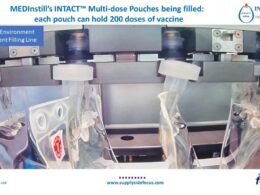JAMA Network (Journal of the American Medical Association)
Mehul D. Patel, PhD1; Erik Rosenstrom, BS2; Julie S. Ivy, PhD2; et al
June 1, 2021
Key Messages:
- Simulation outcomes suggest that removing NPIs while vaccines are distributed may result in substantial increases in infections, hospitalizations, and deaths.
- Furthermore, as NPIs are removed, higher vaccination coverage with less efficacious vaccines can contribute to a larger reduction in risk of SARS-CoV-2 infection compared with more efficacious vaccines at lower coverage.
- These findings highlight the need for well-resourced and coordinated efforts to achieve high vaccine coverage and continued adherence to NPIs before many prepandemic activities can be resumed.
Key Points
Question
What is the association of COVID-19 vaccine efficacy and coverage scenarios with and without nonpharmaceutical interventions (NPIs) with SARS-CoV-2 infections, hospitalizations, and deaths?
Findings
A decision analytical model of North Carolina found that removing NPIs while vaccines were distributed resulted in substantial increases in infections, hospitalizations, and deaths. Furthermore, as NPIs were removed, higher vaccination coverage with less efficacious vaccines contributed to a larger reduction in risk of infection compared with more efficacious vaccines at lower coverage.
Meaning
These findings highlight the need for high COVID-19 vaccine coverage and continued adherence to NPIs before safely resuming many prepandemic activities.
Abstract
Importance
Vaccination against SARS-CoV-2 has the potential to significantly reduce transmission and COVID-19 morbidity and mortality. The relative importance of vaccination strategies and nonpharmaceutical interventions (NPIs) is not well understood.
Objective
To assess the association of simulated COVID-19 vaccine efficacy and coverage scenarios with and without NPIs with infections, hospitalizations, and deaths.
Design, Setting, and Participants
An established agent-based decision analytical model was used to simulate COVID-19 transmission and progression from March 24, 2020, to September 23, 2021.
The model simulated COVID-19 spread in North Carolina, a US state of 10.5 million people. A network of 1 017 720 agents was constructed from US Census data to represent the statewide population.
Exposures
Scenarios of vaccine efficacy (50% and 90%), vaccine coverage (25%, 50%, and 75% at the end of a 6-month distribution period), and NPIs (reduced mobility, school closings, and use of face masks) maintained and removed during vaccine distribution.
Main Outcomes and Measures
Risks of infection from the start of vaccine distribution and risk differences comparing scenarios. Outcome means and SDs were calculated across replications.
Results
In the worst-case vaccination scenario (50% efficacy, 25% coverage), a mean (SD) of 2 231 134 (117 867) new infections occurred after vaccination began with NPIs removed, and a mean (SD) of 799 949 (60 279) new infections occurred with NPIs maintained during 11 months.
In contrast, in the best-case scenario (90% efficacy, 75% coverage), a mean (SD) of 527 409 (40 637) new infections occurred with NPIs removed and a mean (SD) of 450 575 (32 716) new infections occurred with NPIs maintained.
With NPIs removed, lower efficacy (50%) and higher coverage (75%) reduced infection risk by a greater magnitude than higher efficacy (90%) and lower coverage (25%) compared with the worst-case scenario (mean [SD] absolute risk reduction, 13% [1%] and 8% [1%], respectively).

Conclusions and Relevance
Simulation outcomes suggest that removing NPIs while vaccines are distributed may result in substantial increases in infections, hospitalizations, and deaths.
Furthermore, as NPIs are removed, higher vaccination coverage with less efficacious vaccines can contribute to a larger reduction in risk of SARS-CoV-2 infection compared with more efficacious vaccines at lower coverage.
These findings highlight the need for well-resourced and coordinated efforts to achieve high vaccine coverage and continued adherence to NPIs before many prepandemic activities can be resumed.
About the authors
Mehul D. Patel, PhD1;
Erik Rosenstrom, BS2;
Julie S. Ivy, PhD2;
Maria E. Mayorga, PhD2;
Pinar Keskinocak, PhD3;
Ross M. Boyce, MD, MSc4;
Kristen Hassmiller Lich, PhD5;
Raymond L. Smith III, PhD6;
Karl T. Johnson, BA5;
Paul L. Delamater, PhD7;
Julie L. Swann, PhD2
- Department of Emergency Medicine, School of Medicine, University of North Carolina at Chapel Hill
- Department of Industrial and Systems Engineering, North Carolina State University, Raleigh
- Department of Industrial and Systems Engineering, Georgia Institute of Technology, Atlanta
- Division of Infectious Diseases, School of Medicine, University of North Carolina at Chapel Hill
- Department of Health Policy and Management, Gillings School of Global Public Health, University of North Carolina at Chapel Hill
- Department of Engineering, College of Engineering and Technology, East Carolina University, Greenville, North Carolina
- Department of Geography, College of Arts and Sciences, University of North Carolina at Chapel Hill
Originally published at
Citation
Patel MD, Rosenstrom E, Ivy JS, et al. Association of Simulated COVID-19 Vaccination and Nonpharmaceutical Interventions With Infections, Hospitalizations, and Mortality. JAMA Netw Open. 2021;4(6):e2110782. doi:10.1001/jamanetworkopen.2021.10782













